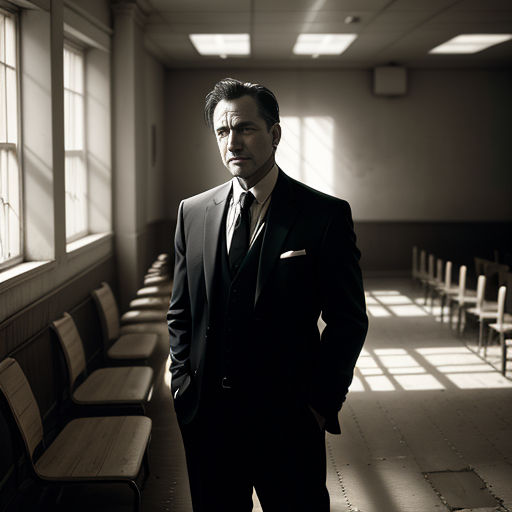
The Chatterbox
By neda

18 Sep, 2023

There was Tony, the biggest Chatterbox in town. He was always seen talking, mostly about insignificant things. Nothing could turn off his chatter, not even a cold rainy day.

He'd show up daily at the local coffee shop. He'd prattle on about the weather, the state of the economy, or the movie he'd seen the night before.

Tony wasn’t shy about sharing his opinions with the world. He'd talk at length about subjects he knew nothing about—like astrophysics or molecular gastronomy.

He was like an incessant radio broadcaster, repeating the same points over and over again. Sometimes, he'd even talk over other people.

His claims of knowledge seemed like heavy makeup attempting to cover glaring flaws. But most folks at the café realized that Tony was just a Chatterbox.

Nancy, a regular visitor, was one of those people. She was a quiet woman who liked her coffee black and her conversations short. She often found herself the unwilling audience to Tony's chatter.

Tony approached Nancy one day and started rambling about a recipe he'd read in a culinary magazine. Nancy, not much of a cook, simply nodded along.

But Tony's endless chatter wasn’t without consequences. With each passing day, the café's regulars started showing up less frequently, unable to bear Tony's constant blabbering.

Even Nancy, who was one of the most patient among them, was close to her wit's end. Yet, Tony seemed oblivious to everyone's discomfort.

Seeing her favourite café on the verge of losing out, Nancy decided she had to do something. So, she thought of a plan to tackle Tony, the Chatterbox.

The next day, Nancy came prepared. She brought with her a thick book titled "Understanding the Silence". She positioned herself at a table, right across from Tony.

As usual, Tony approached her, ready to launch into a monologue. But Nancy simply held up her book, saying, "I’m studying, Tony. I need silence."

Tony was taken aback by the interruption. But he managed a chuckle and simply moved to another table, finding another unsuspecting victim for his chatter.

Nancy's plan seemed to have failed. Yet, she didn't give up. For the next few days, she continued to read her book in the café, constantly reminding Tony of her need for silence.

Slowly, the others in the café started following Nancy's lead. They began carrying books, headphones, or pretended to be engrossed in work – anything to ward off Tony's chatter.

Tony was perplexed. He didn't understand why his morning audience was suddenly so uninterested. But the regulars' determination to avoid his chatter was unwavering.

Days turned into weeks, and the café regulars kept their silent protest against Tony's constant banter. The café was quieter than it had ever been.

Tony realized he was being avoided, and it made him feel lonely. He missed the interactions, the debates, and even the annoyed glances he used to get.

He began to reflect on his behaviour and realized that his constant chatter was not communication. It was a monologue, a one-way street that led to nowhere.

Tony decided to change. The next day, he returned to the café, greeted Nancy, and then sat at his usual spot, quiet. He exchanged pleasantries with others, but didn't launch into his usual monologues.

Over the next days, Tony learned to listen more than he spoke. He asked others about their days and actually waited for their responses. Conversations in the café were becoming two-way streets.

Slowly, the café's regulars started talking to Tony again. They found him more engaging now that he was interested in what others had to say, rather than just hearing his own voice.

Nancy was pleased to see the transformation in Tony. She admired his efforts to change and appreciated the newfound peace that had descended on their favourite café.

Tony still liked talking. But he had learned the art of balance between talking and listening. He was no longer a Chatterbox, but a good conversationalist.

The café was full again, buzzing with the sound of conversations rather than monologues. Tony was part of it all, but with a newfound respect for silence.

Nancy looked at Tony from her corner, a soft smile playing on her lips. She closed her book, sipped her coffee, and joined in the conversation with Tony.

Tony had learned a valuable lesson. He realized that silence was not his enemy but a friend, helping him create conversations that were meaningful and engaging.

The transformation of the Chatterbox was a reminder for everyone. As much as talking is important, listening is equally vital to make a conversation worthwhile.

Tony, who had once drowned the café with his chatter, was now a symbol of change. He was the man who learned to value silence and appreciate the benefits it brought.

Tony's tale was a warning about the power of endless chatter. But more importantly, it was a lesson about listening. For in the silence, we find the space to listen, understand, and engage in real conversations.

So, the next time you encounter a Chatterbox, remember Tony. And remember that everyone has the potential for change, if only we learn to embrace the silence.

As for the café, it thrived with its symphony of conversations. And there, in the heart of all the chatter, sat Tony, listening as much as he spoke, forever a changed Chatterbox.

And Nancy, she never forgot the book "Understanding the Silence". It had served its purpose and now rested on her bookshelf, a silent testament to the power of patience and silence.

The story of the Chatterbox serves as a reminder of the power of conversation over mindless chatter. A true conversation is a dialogue, not a monologue. And in the silence, we find the strength of the spoken words.

Remember, don't ever be a Tony, or as some may call it, a Chatterbox. Embrace silence, learn to listen, and truly understand the essence of conversation.